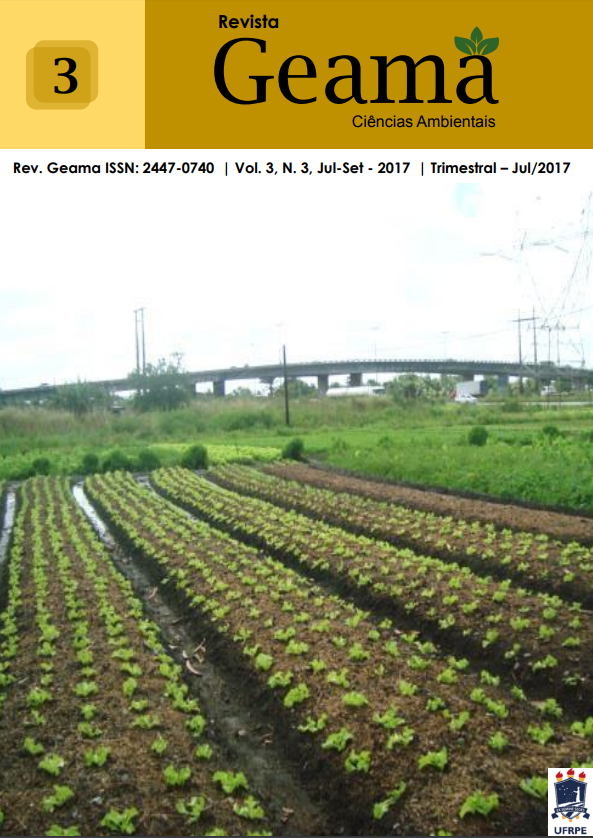Reference Evapotranspiration Estimation in Climate Change Scenarios for Rio Verde in the State of Goiás, Brazil
Palavras-chave:
global climate model, evapotranspirometric demand, irrigated agricultureResumo
Long-term changes in evapotranspiration can have extreme effects in hydrological processes as well as crop yields. The objective of this study was to quantify the expected changes in evapotranspiration in climate change scenarios using the Penman Monteith/FAO56 (PM) standard method and empirical equations for estimating reference evapotranspiration (ET0), specifically for the conditions of Rio Verde, in the state of Goiás, Brazil. Data from the National Institute of Meteorology, and Meteorology and Hydrology System of the State of Goiás were used to estimate the ET0 by using the following methods: Modified Penman, Radiation, Blaney-Criddle, Hargreaves-Samani, and Priestley-Taylor and Turc, which were compared with the PM method on the daily scale. From the ET0 obtained in each of these methods, their performance was evaluated through statistical indices in four future climate scenarios. The projections originated from two emission scenarios based on the HadGEM2-ES global climate model with medium (2040-2069) and long (2070-2099) term scenarios. The results presented that the Radiation and Turc methods are currently—and can be under the predicted conditions of future climate scenarios—the best options for estimation of ET0 in Rio Verde, when meteorological data are not available to implement the PM method. The Modified Penman and the Hargreaves-Samani methods should not be considered for estimating ET0 in the location evaluated.Downloads
Referências
ALLEN, R. G.; PEREIRA, L. S.; RAES, D.; SMITH, M. Crop evapotranspiration: Guidelines for computing crop water requirements. Rome: FAO, 1998. 300 p. (FAO – Irrigation and Drainage Paper, 56).
AMBRAZZI, T.; ROCHA, R. P.; MARENGO, J. A.; PISNITCHENCO, I.; NUNES, L.; FERNANDEZ, J. P. R. Cenários regionalizados de clima no Brasil e América do Sul para o século XXI: Projeções de clima futuro usando três modelos regionais – Relatório n°3. Ministério do Meio Ambiente; Secretária da Biodiversidade e Florestas; Diretoria de Conservação e Biodiversidade, p. 73, 2007.
CAVALCANTI JÚNIOR, E. G.; OLIVEIRA, A. D.; ALMEIDA, B. M.; ESPÍNOLA SOBRINHO, J. Métodos de estimativa da evapotranspiração de referência para as condições do semiárido Nordestino. Semina, Londrina, v.32, p.1699-1708, 2011.
IPCC 2013 Climate Change 2013: The Physical Science Basis. Working Group I Contribution to the Intergovernmental Panel on Climate Change Fifth Assessment Report (Cambridge: Cambridge University Press)
KASHYAP, P. S.; PANDA, R. K. Evaluation of evapotranspiration estimation methods and development of crop-coefficients for potato crop in a sub-humid region. Agricultural Water Management, Amsterdan, v. 50, n. 1, p. 9-25, 2001.
KOEDYK, L. P.; KINGSTON, G. G. Potential evapotranspiration method influence on climate change impacts on river flow: a mid-latitude case study. Hidrology Research, London, v.48, n.2, p.951-963, 2016.
MARENGO, J. A. Mudanças Climáticas: Detecção e cenários futuros para o Brasil até o final do século XXI. In: CAVALCANTI, I. F. A.; FERREIRA, N. J.; SILVA, M. G. J.; SILVA DIAS, M. A. F. Tempo e Clima no Brasil. São Paulo: Ed. Oficina de Textos, 2009. p. 407-424.
MOLINA, M. M. Climate change effects on evapotranspiration in Mexico. American Journal of Climate Change, v.4, p.163-172, 2015.
OLIVEIRA, L. F. C.; CARVALHO, D.; F.; ROMÃO, P. A. ; CORTÊS, F. C. Estudo comparativo de modelos de estimativa da evapotranspiração de referência para algumas localidades no estado de Goiás e Distrito Federal. Pesquisa Agropecuária Tropical, Goiânia, v. 31, n.2, p. 121-126, 2001.
OLIVEIRA, R.; Z.; OLIVEIRA, L. F. C.; WEHR, T.; R.; BORGES, L. B.; BONOMO, R. Comparação de metodologias de estimativa da evapotranspiração de referência para a região de Goiânia, GO. Bioscience Journal, Uberlândia, v. 21, n.3, p. 19-27, 2005.
PRADO, L. C.; LEAL, B. G. Meteorological variables influence analysis over Petrolina –Juazeiro pole monthly reference evapotranspiration. Latin America Transactions, v.14, n.10, p.4373-4376, 2016.
PBMC, 2013. Contribuições do Grupo de Trabalho 1 ao Primeiro Relatório de Avaliação Nacional do Painel Brasileiro de Mudanças Climáticas. Sumário Executivo GT1 Painel Brasileiro de Mudanças Climáticas (PBMC). [s.l: s.n.]. Disponível em: <http://www.pbmc.coppe.ufrj.br/documentos/MCTI_PBMC_SumárioExecutivo4_Finalizado.pdf>.
TAYLOR, K. E.; STOUFFER, R. J.; MEEHL, G. a. A Summary of the CMIP5 Experiment Design. Disponível em: <http://cmip-pcmdi.llnl.gov/cmip5/docs/Taylor_CMIP5_design.pdf>.
WILBY, R. L.; CHARLES, S. P.; ZORITA, E.; TIMBAL, B.; WHETTON, P.; MEARNS, L. O. Guidelines for Use of Climate Scenarios Developed from Statistical Downscaling Methods. Analysis, v. 27, p. 1–27, 2004. Disponível em: <http://www.ctn.etsmtl.ca/cours/mgc921/dgm_no2_v1_09_2004.pdf>.
XAVIER, A. C.; KING, C. W.; SCANLON, B. R. Daily gridded meteorological variables in Brazil (1980-2013). International Journal of Climatology, Malen, v.36, p.2644-2659, 2015.
Downloads
Publicado
Como Citar
Edição
Seção
Licença
As Políticas Culturais em Revista aplica a Licença Creative Commons Atribuição-Não Comercial 4.0 Internacional (CC BY-NC-SA 4.0) para os trabalhos que publica. Esta licença foi desenvolvida para facilitar o acesso aberto - ou seja, o acesso livre, imediato, e a reutilização irrestrita de trabalhos originais de todos os tipos. Nossos autores mantêm os direitos autorais mas, sob essa licença, concordam em deixar os artigos legalmente disponíveis para reutilização, sem necessidade de permissão ou taxas, para praticamente qualquer finalidade. Qualquer pessoa pode copiar, distribuir ou reutilizar esses artigos, desde que o autor e a fonte original (Políticas Culturais em Revista) sejam devidamente citados.
![]()






